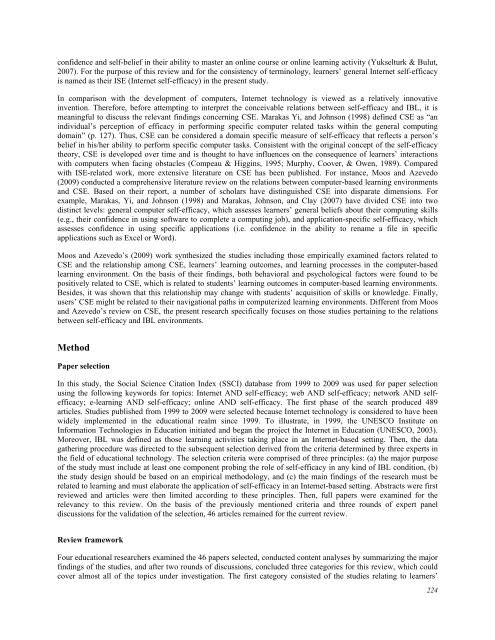October 2011 Volume 14 Number 4 - Educational Technology ...
October 2011 Volume 14 Number 4 - Educational Technology ...
October 2011 Volume 14 Number 4 - Educational Technology ...
Create successful ePaper yourself
Turn your PDF publications into a flip-book with our unique Google optimized e-Paper software.
confidence and self-belief in their ability to master an online course or online learning activity (Yukselturk & Bulut,<br />
2007). For the purpose of this review and for the consistency of terminology, learners’ general Internet self-efficacy<br />
is named as their ISE (Internet self-efficacy) in the present study.<br />
In comparison with the development of computers, Internet technology is viewed as a relatively innovative<br />
invention. Therefore, before attempting to interpret the conceivable relations between self-efficacy and IBL, it is<br />
meaningful to discuss the relevant findings concerning CSE. Marakas Yi, and Johnson (1998) defined CSE as “an<br />
individual’s perception of efficacy in performing specific computer related tasks within the general computing<br />
domain” (p. 127). Thus, CSE can be considered a domain specific measure of self-efficacy that reflects a person’s<br />
belief in his/her ability to perform specific computer tasks. Consistent with the original concept of the self-efficacy<br />
theory, CSE is developed over time and is thought to have influences on the consequence of learners’ interactions<br />
with computers when facing obstacles (Compeau & Higgins, 1995; Murphy, Coover, & Owen, 1989). Compared<br />
with ISE-related work, more extensive literature on CSE has been published. For instance, Moos and Azevedo<br />
(2009) conducted a comprehensive literature review on the relations between computer-based learning environments<br />
and CSE. Based on their report, a number of scholars have distinguished CSE into disparate dimensions. For<br />
example, Marakas, Yi, and Johnson (1998) and Marakas, Johnson, and Clay (2007) have divided CSE into two<br />
distinct levels: general computer self-efficacy, which assesses learners’ general beliefs about their computing skills<br />
(e.g., their confidence in using software to complete a computing job), and application-specific self-efficacy, which<br />
assesses confidence in using specific applications (i.e. confidence in the ability to rename a file in specific<br />
applications such as Excel or Word).<br />
Moos and Azevedo’s (2009) work synthesized the studies including those empirically examined factors related to<br />
CSE and the relationship among CSE, learners’ learning outcomes, and learning processes in the computer-based<br />
learning environment. On the basis of their findings, both behavioral and psychological factors were found to be<br />
positively related to CSE, which is related to students’ learning outcomes in computer-based learning environments.<br />
Besides, it was shown that this relationship may change with students’ acquisition of skills or knowledge. Finally,<br />
users’ CSE might be related to their navigational paths in computerized learning environments. Different from Moos<br />
and Azevedo’s review on CSE, the present research specifically focuses on those studies pertaining to the relations<br />
between self-efficacy and IBL environments.<br />
Method<br />
Paper selection<br />
In this study, the Social Science Citation Index (SSCI) database from 1999 to 2009 was used for paper selection<br />
using the following keywords for topics: Internet AND self-efficacy; web AND self-efficacy; network AND selfefficacy;<br />
e-learning AND self-efficacy; online AND self-efficacy. The first phase of the search produced 489<br />
articles. Studies published from 1999 to 2009 were selected because Internet technology is considered to have been<br />
widely implemented in the educational realm since 1999. To illustrate, in 1999, the UNESCO Institute on<br />
Information Technologies in Education initiated and began the project the Internet in Education (UNESCO, 2003).<br />
Moreover, IBL was defined as those learning activities taking place in an Internet-based setting. Then, the data<br />
gathering procedure was directed to the subsequent selection derived from the criteria determined by three experts in<br />
the field of educational technology. The selection criteria were comprised of three principles: (a) the major purpose<br />
of the study must include at least one component probing the role of self-efficacy in any kind of IBL condition, (b)<br />
the study design should be based on an empirical methodology, and (c) the main findings of the research must be<br />
related to learning and must elaborate the application of self-efficacy in an Internet-based setting. Abstracts were first<br />
reviewed and articles were then limited according to these principles. Then, full papers were examined for the<br />
relevancy to this review. On the basis of the previously mentioned criteria and three rounds of expert panel<br />
discussions for the validation of the selection, 46 articles remained for the current review.<br />
Review framework<br />
Four educational researchers examined the 46 papers selected, conducted content analyses by summarizing the major<br />
findings of the studies, and after two rounds of discussions, concluded three categories for this review, which could<br />
cover almost all of the topics under investigation. The first category consisted of the studies relating to learners’<br />
224

















